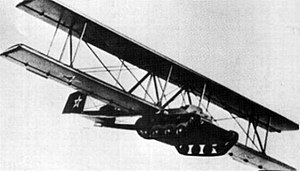Winged tank: Difference between revisions
m Reverted edits by 199.185.67.166 (talk) to last version by Jackehammond |
Tag: nonsense characters |
||
| Line 21: | Line 21: | ||
==Japanese models== |
==Japanese models== |
||
urtryug-9prwigwer9te-f9wrtg8er9orgytureiolfkgjhrueiwolfkvmgnhfurieldfgnhfriedlfnghfueiosldfmnhesld,mfnghfjdk,cfmvnghfjdklkfmvnghfudikcfmvnghjfkdfgjnfidolkgjjdghvj;fdgidfgpdfp fuck you |
|||
The Imperial Japanese Army's experimental [[Special No. 3 Flying Tank]] ''So-Ra'' or ''Ku-Ro'', was developed in 1943. Like the Soviet models, it had detachable wings, but it could also be transported by heavy gliders, namely the [[Kokusai Ku-7]] "Buzzard" and [[Kokusai Ku-8]] I "Gander". These could be towed by aircraft such as the [[Mitsubishi Ki-21]] "Sally" heavy bomber. However, the Japanese Flying Tank project was abandoned before it went into production. The tank transport gliders were deployed to the Philippines during 1944. Another prototype was [[Maeda Ku-6 Flying Tank]], but not advanced to experimental phases also. |
|||
==After World War II== |
==After World War II== |
||
Revision as of 15:31, 19 April 2011

Tanks with glider wings were the subject of several unsuccessful experiments in the twentieth century. It was intended that these could be towed behind; or carried under an airplane, to glide into a battlefield, in support of infantry forces.
In war, airborne forces use parachutes to drop soldiers behind enemy lines to capture and hold important objectives until more heavily-equipped friendly troops can arrive. Military planners have always sought ways to provide airborne troops with combat support equipment in the form of light armoured vehicles or artillery which can be dropped by parachute or military glider.
The biggest problem with air-dropping vehicles is that their crews drop separately, and may be delayed or prevented from bringing them into action. Military gliders allow crews to arrive at the drop zone along with their vehicles. They also minimize exposure of the valuable towing aircraft, which needn't appear over the battlefield. An improvement would be a tank which could glide into the battlefield, drop its wings, and be ready to fight within minutes.
In the early 1930s, American engineer Walter Christie experimented with flying tanks.[1] Later, the Royal Air Force tested the Baynes Bat, a flying wing intended to carry a light tank—the one-third scale prototype flew well, but no suitable tank was available.
Soviet experiments

In the early twentieth century, parachute silk was rare in the Soviet Union, so the military conducted dubious experiments with air-dropping soldiers into deep snow without parachutes. In 1930, the Grokhovskiy Special Design Bureau experimented with dropping "air buses" full of troops: the bicycle-wheeled G-45 onto land, and the amphibious "hydro bus" into water. When the hydro bus disintegrated on landing, the chief designer and his assistant were strapped into the G-45 for a test drop; they survived, but the project was cancelled (Zaloga 1984:192).
Later, the Soviets used heavy bombers to land on the battlefield carrying T-27 tankettes and light tanks, and experimented with air-dropping light tanks (both with and without parachutes). In 1941, airborne units were issued T-40 amphibious tanks.
None of these was completely satisfactory, so in 1942 the Soviet Air Force ordered Oleg Antonov to design a glider for landing tanks. Antonov was more ambitious, and instead added a detachable cradle to a lightened T-60 light tank, bearing large wood and fabric biplane wings and twin tail. Although one semi-successful test flight was completed, due to the lack of sufficiently-powerful aircraft to tow it at the required 160 km/h, the project was abandoned.
Japanese models
urtryug-9prwigwer9te-f9wrtg8er9orgytureiolfkgjhrueiwolfkvmgnhfurieldfgnhfriedlfnghfueiosldfmnhesld,mfnghfjdk,cfmvnghfjdklkfmvnghfudikcfmvnghjfkdfgjnfidolkgjjdghvj;fdgidfgpdfp fuck you
After World War II
The Soviet Union continued to develop methods to efficiently deploy airborne vehicles. By the mid-1970s they were able to drop BMD-1 fighting vehicles with crew members aboard, using a combination of parachutes and retrorocket.
References
- Holt, Lew. “Flying Tanks that Shed Their Wings” in Modern Mechanics and Inventions, July 1932.
- Shavrov, V. (1997). "Istoriya konstruktsiy samoletov v SSSR". Bronekollektsiya (4).
{{cite journal}}: Cite has empty unknown parameters:|month=and|coauthors=(help) - Zaloga, Steven J. (1984). Soviet Tanks and Combat Vehicles of World War Two. London: Arms and Armour Press. pp. 192–3. ISBN 0-85368-606-8.
{{cite book}}: Unknown parameter|coauthors=ignored (|author=suggested) (help)
- ^ "Flying Tank - Newest Air Menace", July 1932, Popular Mechanics 1932 article with drawings
See also
- Military glider
- General Aircraft Hamilcar, a military glider of the period capable of carrying light tanks.
- Messerschmitt Me 321 and Junkers Ju 322, German gliders designed to be capable of carrying light armored vehicles.
- The T-80 and T-84 have also been nicknamed Flying Tank for their speed
